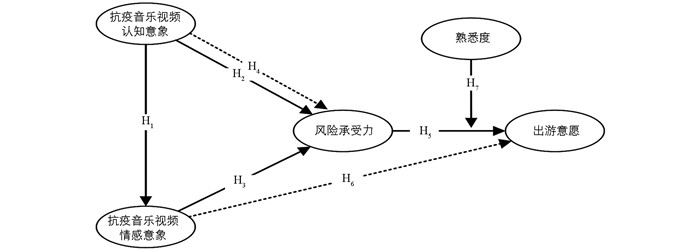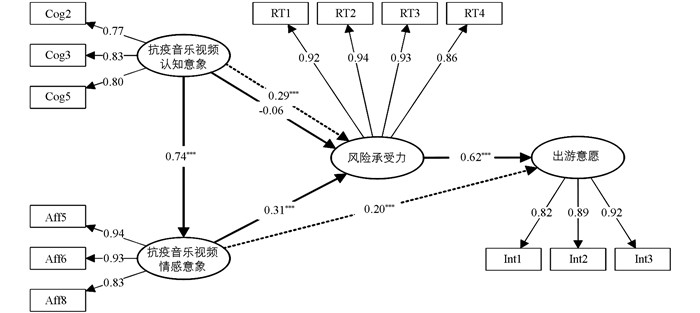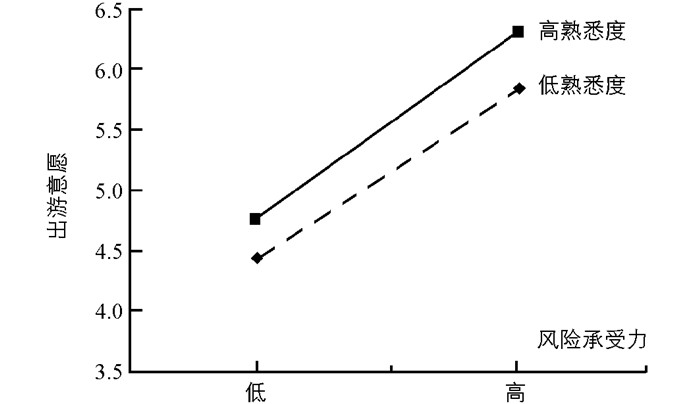-
近年来,风险承受力的概念在卫生、金融领域发挥着重要作用,其作为个人态度和行为的重要决定因素已经在行为科学研究中得到证实[1].风险承受力是反应一个人对承担风险态度的心理学概念[2]. Dohmen等[3]揭示了一般风险承受力与特定领域的风险行为有着强烈的关联,比如驾驶、金融、运动等. Lerche等[4]将风险承受力作为公司或决策者在不能接受预期损失时的边际价值.在旅游学中,风险承受力的研究多集中在特殊的旅游活动中;Cohen[5]认为在探险旅游、漂流旅游等情境下,旅游者对不确定性的承受力能够较好地预测旅游行为;Plog[6]在旅游者的风险偏好与目的地选择行为之间建立了联系,但并未直接测量风险承受力.旅游决策是在连续的信息、风险和不确定性下产生的[7],尤其在自然灾害、公共卫生事件和恐怖袭击等特殊情境下,风险承受力对旅游决策具有重要影响[1].
2019年末爆发的新冠肺炎疫情至今已经持续了4个多月的时间,截至北京时间2020年5月6日6时30分,疫情已经波及至全球100多个国家,累计造成372万人感染,对世界经济产生了巨大的冲击和影响,属于人类历史上罕见的重大公共卫生事件.武汉作为中国最早爆发疫情的城市,依托海内外的援鄂抗疫行动,已经逐渐走出疫情阴霾,获得阶段性的抗疫胜利.在此次疫情期间,多首抗疫音乐视频应景应情而生,其广泛传播引起了极大的社会共情.其中,呈现有武汉地方意象的音乐视频《武汉伢》创造了极高的网络点击率,增加了大众对武汉的感知和了解,并激发了疫情后“相约武汉”的出游意愿.根据Bruce等[8]的研究,重大危机之后人的出游意愿更多基于对安全需求的考量和风险承受力的评估.尽管在部分旅游研究中探讨和应用了行为经济学中风险承受力的概念[8-10],但实证研究依然匮乏[1].在重大疫情下,潜在旅游者风险承受力对出游意愿的作用机制,仍有待进一步研究补充.
本研究选取了具有代表性的抗疫音乐视频《武汉伢》作为研究素材,以其所传播的地方意象为前因变量,熟悉度为调节变量,力图揭示潜在旅游者风险承受力对出游意愿的作用机制,以期在未来发生类似危机的情境下,让理论更好地指导实践,引导潜在旅游者正视重大疫情带来的风险,帮助和引导旅游目的地快速走出阴霾,恢复产业活力.
全文HTML
-
地方意象通常被定义为人对于特定地方所持有的信念、观念和印象的总和[11],是一种基于大量信息选择之上所形成的心理印象[12-13].在旅游研究中,地方意象一般划分为认知意象和情感意象[14].认知意象指旅游者对目的地功能属性的感知,对目的地客观对象与环境的知觉和评价[15-16];情感意象则与心理因素相关,是人对目的地的感觉与情感联结[17],也是旅游者对目的地情感品质的抽象感受[14, 18].认知意象和情感意象是层次分明又相互联系的两个维度[19],且认知意象对情感意象存在显著的正向影响[20-23].由此,得到假设1.
H1:基于抗疫音乐视频的认知意象对情感意象具有正向作用.在旅游目的地营销中,及时、准确地发掘旅游者的情感需求,传播能够触动旅游者心灵的、独具特色的目的地意象,利于强化旅游者感知利得,弱化感知风险[24-25].研究发现,通过媒体传播了解更多信息能够有效降低消费者的感知风险[26]. Qu等[27]认为传播积极正向的目的地意象有助于降低旅游者对潜在风险的担忧程度.姜科[28]认为在汶川地震之后,通过目的地推广的宣传片能够增加潜在旅游者对目的地恢复状况的了解,引导潜在旅游者正确认识目的地旅游环境,从而提高其风险承受力.以抗击重大疫情为题材的音乐视频,尤其是呈现疫区地方意象的音乐视频,能够增加受众的目的地认知,引发受众的情感共鸣,从而有效提高潜在旅游者风险承受力.并且在地方意象中,认知是情感产生的基础,情感在认知与其他变量之间起着中介作用[29-30].由此,得到假设2、假设3和假设4.
H2:基于抗疫音乐视频的认知意象对潜在旅游者风险承受力具有正向作用.
H3:基于抗疫音乐视频的情感意象对潜在旅游者风险承受力具有正向作用.
H4:基于抗疫音乐视频的情感意象在认知意象与潜在旅游者风险承受力之间具有中介作用.
-
出游意愿,是人主观判断其未来发生旅游行为的倾向[31],是游客参与某种旅游活动的意愿[32].旅游者的风险承受能力是其态度和行为的重要决定因素[1].常规情况下,风险带来的不确定性会影响旅游者目的地选择和旅游行为[33-34];特殊情境下,旅游者的风险承受力对于出游行为具有更合理的解释.李承哲等[35]指出在寻求新奇感的旅游活动中,风险承受力能够较好地预测旅游行为. Elsrud [36]提出,背包客被特殊旅游目的地吸引是因其愿意承担风险,而其他人规避风险.姜科[28]指出在地震后,部分游客出于社会责任感或者好奇心会做出前往地震灾区旅游的决策.可见,潜在旅游者风险承受力大小会直接影响目的地选择和旅游决策.由此,得到假设5.
H5:重大疫情下潜在旅游者风险承受力对其出游意愿具有正向作用.
-
负面因素感知对于理解旅游决策具有重要意义,尤其对旅游风险具有显著作用[34, 37],能够作为传导中介对旅游者态度和行为产生影响.李月调等[38]研究指出,负面舆论通过游客安全感知的传递效应对重游意愿产生作用.陈永昶等[39]将游客感知风险作为中介变量,认为通过提升导游人员的服务质量能够显著降低游客的风险感知,从而提高游客感知价值和满意度.风险承受力作为反映人对承担风险态度的心理状态[2],是理解旅游风险的重要变量,其他因素能够通过影响风险承受力作用于旅游者的态度与行为.在重大疫情下,抗疫音乐视频中传达的情感意象能够加强旅游者与目的地之间的情感联系,提高潜在旅游者风险承受力,促进旅游者出游意愿的产生.由此,得到假设6.
H6:重大疫情下潜在旅游者风险承受力在情感意象与出游意愿之间具有中介作用.
-
目的地熟悉度是旅游者对目的地在视觉或心理上的印象[40],包括旅游者的旅游经验、信息获取等维度.消费领域研究认为,具有较高熟悉度的消费者对于品牌具有更高的信任感,外界负面信息的干扰影响更小[41].同样,在旅游学研究中,熟悉度越高的旅游者出游意愿越高[42-43],并且受到负面信息的影响更小[44]. Wong等[45]认为尽管风险感知使得游客对目的地选择有所犹豫,但旅游者知识能够对此进行调节,研究证实了旅游经验对风险感知与目的地选择的调节作用.熟悉度是一个信息评估的过程[46],熟悉度越高的旅游者对于目的地的信息掌握越全面,从而可以降低风险承受力对出游意愿的冲击和影响.由此,得到假设7.
H7:重大疫情下潜在旅游者熟悉度在风险承受力与出游意愿之间具有调节作用.
综合以上文献,本研究的理论模型与关系假设见图 1.
1.1. 重大疫情下基于抗疫音乐视频的地方意象与风险承受力的关系
1.2. 重大疫情下潜在旅游者风险承受力与出游意愿的关系
1.3. 重大疫情下风险承受力的中介作用
1.4. 重大疫情下熟悉度的调节作用
-
本研究以抗疫音乐视频中的地方意象作为研究起点,选择具有代表性的《武汉伢》作为研究素材.该抗疫歌曲由17位武汉文艺工作者创作,于2020年1月27日发布,之后通过中央电视台剪辑音乐视频(Music Video,以下简称MV)播出后得到广泛关注和传播. 《武汉伢》音乐视频中呈现了大量疫情下武汉的地方景象,选取了长江大桥、江汉路、黄鹤楼等标志性景观,让大众了解了武汉独具特色的地方意象.音乐视频旋律悠扬,娓娓道来,充斥着疫情下的忧伤,唤起听众强烈的地方情感与社会共情.
-
本研究主要借鉴现有的成熟量表作为测量工具,题项采用Likert 7点计分法测量.对于音乐视频中的地方意象,从认知意象和情感意象两个维度进行测量.根据认知意象的功能属性,借鉴Lew[47]与Chen等[48]的量表,并结合音乐视频画面与弹幕,提取出市民生活、街头景象、社会环境、地理景观等4个方面;根据Russell[49]对情感意象的研究,从“愉快” “兴奋” “唤起” “放松”4个方面对情感意象进行测量.对于潜在旅游者风险承受力的测量,在借鉴Alvarez等[50]量表和Williams等[1]定义的基础上,从一般风险特征、特定领域的旅游业风险承受力、以及风险与不确定性进行测量,得到风险承受力的4个指标.对于熟悉度,主要从经历熟悉度[51]、信息熟悉度和贴近熟悉度[52]3个方面进行测量.对于出游意愿,主要从到访意愿、推荐/谈论意愿、优先选择[53]3个方面进行测量.此外,还设计了基本的人口统计学特征题项,即性别、年龄、学历、职业、收入等.
在问卷调查中,首先引导参与者观看《武汉伢》音乐视频至少90 s以上,并对参与者从音乐视频中获取的地方意象进行测量;随后对参与者的风险承受力、熟悉度和出游意愿进行测量.
-
初试问卷通过网络发放,共计回收问卷111份,有效问卷107份,有效回收率为96.4%.调研以国内武汉潜在旅游者作为调查对象,排除了当前常住武汉或在武汉出生长大的人.使用SPSS 22.0软件对初试问卷进行信度检验和探索性因子分析.信度检验结果表明认知意象、情感意象、风险承受力、熟悉度、出游意愿5个维度的Cronbach's α系数分别是0.763,0.761,0.759,0.741,0.872,信度得分均大于0.7,说明该问卷信度良好.接着对问卷数据进行探索性因子分析,KMO(Kaiser-Meyer-Olkin)值为0.763,并顺利抽取出上述5个因子,共解释了数据中68.90%的变异.根据公因子提取的结果,为了更加契合《武汉伢》音乐视频所传达的地方意象,对认知意象中“地理景观”的题项描述修改为“城市面貌”,研究以此为基础形成正式问卷.
正式调研采用网络问卷形式,调研时间为2020年3月23-2020年3月31日.共计回收问卷1 184份,得到有效问卷945份,有效回收率为79.81%,样本的人口学特征见表 1.在样本数据中,男女比例较为均衡,占比分别为47.62%和52.38%;年龄以18~40岁为主,占比为82.33%,这符合青年人群更关注旅游活动、音乐视频的现实情况;学历、收入层次分布较均衡;47.41%的受访者有武汉到访史,对于武汉具有一定程度的了解.总体来看样本数据适合本研究.
2.1. 研究素材选取
2.2. 测量量表设计
2.3. 问卷初试优化与正式数据收集
-
首先,运用SPSS 22.0软件对问卷进行信效度检验.信度检验主要依靠Cronbach's α系数,其值越接近1表示问卷的信度越高,当值达到0.7时为合格,达到0.8时为优良.通过分析可得,认知意象、情感意象、风险承受力、熟悉度和出游意愿的Cronbach's α系数分别为0.835,0.927,0.952,0.888和0.908,整体问卷的Cronbach's α系数达到0.884,大于0.8的标准,说明问卷题项体现出较好的内部一致性.
采用探索性因子分析检验总体量表的结构效度,并据此确定是否需要剔除多余的题项.以主成分分析法提取因子,以方差最大正交旋转获取因子载荷,以特征根大于1为因子提取原则进行因子分析.在KMO和Bartlett检验中,当KMO值越接近1,Bartlett显著性水平越接近0,表示问卷的效度越高.结果显示,本研究的问卷KMO值达到了0.900,Bartlett检验的显著性水平p=0.000,适合进行因子分析.其中,任何因子载荷小于0.4或者两个因子的交叉载荷大于0.4的题项将被剔除.经过因子分析,最终选取了由16个题项测量的5个因子,即认知意象、情感意象、风险承受力、熟悉度和出游意愿,剩余题项的因子载荷均大于0.6,因子的特征根均大于1,累积解释方差达82.140%,表明量表具有理想的结构效度.探索性因子分析结果见表 2.
为了进一步检验量表与测量潜变量的从属关系,利用AMOS 24.0软件进行验证性因子分析,包括对测量模型的拟合优度、信度和效度进行检验.该测量模型的拟合优度指标,如卡方自由度比(CMIN/DF)、拟合优度指数(GFI)、调整后拟合优度指数(AGFI)、渐进残差均方和平方根(RMSEA)、标准化残差均方和平方根(SRMR)、比较适配指数(CFI)、增值适配指数(IFI)和非规准适配指数(TLI)都达到标准(表 3),说明模型整体拟合度较好,可以接受.
潜变量量表信度可以通过组合信度(CR)和平均提取方差(AVE)进行检验,具体分析结果见表 4.一般认为,组合信度大于0.7,聚敛效度大于0.5,说明题项对潜变量测量的信度理想.从表 4可知,各潜变量的组合信度在0.842~0.953之间,大于0.7标准;平均提取方差在0.640~0.836之间,大于0.5标准.这表明潜变量量表具有较高的信度.
效度包括聚合效度和区分效度.一般认为,题项的标准化因子载荷大于0.4,在p值为0.01水平下具有统计学意义,说明测量模型的聚合效度良好[54].从表 4可知,题项的标准化因子载荷在0.766~0.938之间,均达到了0.7的标准,且都具有统计学意义(p=0.000),这表明测量模型具有很好的聚合效度.
最后对各潜变量之间的区分效度进行检验,结果见表 5.一般认为,当各潜变量之间的相关系数小于各潜变量平均提取方差的平方根时,表明区分效度较好[55].从表 5可知,各潜变量平均提取方差的平方根在0.800~0.914之间,相关系数在0.026~0.739之间.纳入结构模型中的认知意象、情感意象、风险承受力、出游意愿4个潜变量之间存在显著的相关性,且均小于潜变量平均提取方差的平方根,说明模型数据区分效度较好.其中,认知意象和情感意象作为地方意象的两个维度,具有较高的相关性;熟悉度作为风险承受力和出游意愿的调节变量,与两个被调节潜变量的相关性显著.
-
以理论模型为基础,通过AMOS 24.0软件构建结构方程模型,选择极大似然估计方法进行估计参数迭代,作用路径的检验结果见图 2.
对提出的假设进行验证(表 6).结果表明,认知意象对情感意象具有显著的正向作用(uStd.=0.809,p<0.001),H1成立;认知意象对风险承受力不具有显著的正向作用(uStd.=-0.080,p>0.05),H2拒绝;情感意象对风险承受力具有显著的正向作用(uStd.=0.366,p<0.001),H3成立;风险承受力对出游意愿具有显著的正向作用(uStd.=0.578,p<0.001),H5成立.因此,假设1、假设3、假设5得到验证.
-
为了进一步探讨认知意象对风险承受力(H4)的作用机制,将情感意象作为中介变量进行检验.同时,对风险承受力在情感意象和出游意愿之间的中介效果(H6)进行检验.由于Bootstrap法无需考虑数据是否正态分布,且统计效果较Sobel检验等方法更好,因此本文采用Bootstrap法检验中介效应[56].样本量设置为2 000,置信水平设置为97.5%,取样方法选择偏差校正百分位数法.如果间接效应的置信区间不包含0,表示中介效应存在;如果直接效应的置信区间不包含0,表示部分中介存在,包含0则表示完全中介存在.结果见表 7,情感意象和风险承受力的中介效应均成立.其中情感意象在认知意象和风险承受力(uStd.=0.292,p<0.001)之间是完全中介作用,97.5%置信区间分别为0.180,0.441;风险承受力在情感意象和出游意愿(uStd.=0.195,p<0.001)之间是部分中介作用,97.5%置信区间分别为0.125,0.282.因此,假设4、假设6得到验证.
-
为了进一步验证熟悉度对风险承受力和出游意愿的调节效应(H7),利用AMOS 24.0软件对风险承受力和熟悉度的交互项进行检验.首先在SPSS 22.0软件中对风险承受力和熟悉度的测量项进行标准化,采用Marsh等[57]的配对乘积指标策略,选取两者的前3个测量项相乘得到交互项的值,然后在AMOS 24.0软件中计算交互项对出游意愿的作用系数,并对标准化系数进行校正[58](表 8).同时绘制调节效应分解图,并进行简单斜率分析(图 3).
由表 8可见,风险承受力和熟悉度的交互项对出游意愿具有显著的正向作用(uStd.=0.051,p<0.001),熟悉度的调节效应显著.由图 3可见,潜在旅游者风险承受力对于出游意愿具有正向作用,并且熟悉度越高的分组,潜在旅游者风险承受力对出游意愿的正向作用越大.因此,熟悉度在风险承受力对出游意愿的影响中起到了正向调节作用.
3.1. 测量模型检验
3.2. 结构模型检验
3.3. 中介效应检验
3.4. 调节效应检验
-
本研究以新冠肺炎疫情为背景,探讨了重大疫情下潜在旅游者风险承受力对出游意愿的作用机制,并加入了抗疫音乐视频中地方意象的前因影响和熟悉度的调节作用.研究结论如下:
1) 在重大疫情下,基于抗疫音乐视频的情感意象对潜在旅游者风险承受力具有正向作用(uStd.=0.366,p<0.001),风险承受力对出游意愿具有正向作用(uStd.=0.578,p<0.001),风险承受力在情感意象与出游意愿之间具有部分中介作用(uStd.=0.195,p<0.001).本结论证实了风险承受力受情感意象的前因影响,又直接作用于潜在旅游者出游意愿,并在两者之间具有传导中介作用,从而验证了风险承受力在疫情后旅游者决策中的重要性.
2) 在重大疫情下,基于抗疫音乐视频的认知意象对情感意象具有显著正向作用(uStd.=0.809,p<0.001),认知意象对潜在旅游者风险承受力没有直接作用(uStd.=-0.080,p>0.05),情感意象在认知意象与风险承受力之间具有完全中介作用(uStd.=0.292,p<0.001).可见,在重大疫情下,人们的认知意象不再单纯地关注城市景观、地方特色等,而是透过城市面貌进一步关注疫情的负面影响.因此,疫情的负面影响干扰了认知意象对潜在旅游者风险承受力的作用,H2直接作用不显著.然而,这种认知意象有助于促进情感意象的产生,基于抗疫音乐视频的情感意象具有强烈的感染力和影响力,直接作用于潜在旅游者风险承受力.本结论证实了认知意象通过情感意象的传递效应对风险承受力发生作用,情感意象对重大疫情下潜在旅游者感知具有重要影响.
3) 在重大疫情下,熟悉度在风险承受力和出游意愿之间具有正向调节作用(uStd.=0.051,p<0.001).本结论证实了熟悉度与风险承受力的交互项对出游意愿的正向影响,即具有高熟悉度的潜在旅游者能够对目的地风险进行更全面地判断,具有更高的风险承受力,从而降低疫情对出游意愿的冲击和影响.
-
本研究在新冠肺炎疫情背景下,探讨了基于抗疫音乐视频的地方意象、风险承受力、熟悉度、出游意愿之间的关系,研究的理论贡献如下:
1) 本研究将风险承受力引入旅游决策研究中,探讨了重大疫情下潜在旅游者风险承受力对出游意愿的作用机制,从而拓展了旅游决策相关理论.在以往的旅游研究中对风险承受力探讨较少,并且局限于探险旅游、漂流旅游等情境下,缺少从旅游目的地危机管理视角的研究,少有探讨公共卫生安全事件、自然灾害等特殊情境下风险承受力对旅游活动影响的研究.在重大疫情下,风险承受力纳入了更多情感因素、价值判断的影响,对个人的实际出游意愿具有更直接和合理的解释.通过研究重大疫情下潜在旅游者风险承受力的作用机制,将其纳入到更多旅游情境的讨论中,拓展了风险承受力在旅游研究中的应用,为旅游目的地危机管理提供了理论支持.
2) 本研究探讨了抗疫音乐视频中的地方意象对潜在旅游者风险承受力和出游意愿的影响,从而为音乐视频和地方意象在旅游领域的研究提供了新的切入点.尽管早有学者关注目的地音乐、影视作品对旅游者感知、目的地形象、旅游决策等方面的影响,但是对目的地音乐视频内容的挖掘不足,忽略了其中地方意象元素的影响.尤其在重大疫情下,富有地方意象的文艺作品更能唤起人们的地方情感,引发共鸣,从而作用于潜在旅游者风险承受力和出游意愿.本研究通过关注抗疫音乐视频中地方意象的影响,拓宽了旅游者感知与决策研究内容,为旅游目的地营销提供了理论支持.
3) 本研究证实了熟悉度在潜在旅游者风险承受力和出游意愿之间的调节作用,为熟悉度的旅游研究提供了新的视角.在旅游领域中,对熟悉度的研究集中在其对目的地形象、游客感知、重游意愿等方面的影响,但并未突出熟悉度的关键作用.在重大疫情下,熟悉度作为潜在旅游者和目的地之间的联系纽带,对引导潜在旅游者正视目的地疫情风险、激发目的地出游意愿具有重要作用.在特殊情境下,通过提升目的地熟悉度,能够有效缓解负面因素对旅游目的地的影响,加强潜在旅游者与目的地之间的联系,从而提升潜在旅游者出游意愿.本研究强调了熟悉度在特殊情境下的关键作用,为旅游目的地危机管理提供了理论支持.
-
此次新冠肺炎疫情对世界旅游业带来了极大冲击,对旅游业恢复发展提出了全新挑战.如何有效提升潜在旅游者出游意愿,恢复潜在旅游者出游信心,成为决定旅游目的地未来发展的关键议题.在重大疫情下,由于旅游目的地存在风险和不确定性,潜在旅游者风险承受力将直接影响其对目的地的旅游决策.因此,本文针对疫情危机,结合研究结论提出以下目的地危机管理对策:
1) 重大疫情下应加强旅游公共卫生安全管理,提升潜在旅游者风险承受力,增强潜在旅游者出游信心.旅游目的地在面对重大疫情时,应及时启动公共卫生安全管理体系,按照世界卫生组织以及国家有关规定,通过多渠道公开疫情相关信息.在充分保障旅游目的地卫生应急物资供应的基础上,提升车站、机场、服务站等枢纽中心的应急管理能力,加强人流聚集景区的卫生监测能力,培养旅游从业人员应对疫情危机的专业应对能力.同时,建立目的地公共卫生安全响应的长效机制,实施景区预约和导游监督制,增强目的地人流管理和疏散能力,提升旅游者安全感知效能,促进潜在旅游者的出游意愿,为疫情后旅游业的可持续发展提供完善保障.
2) 重大疫情下应充分利用文化传播媒介,积极传播地方意象,加强潜在旅游者与目的地之间的情感联系.通过创作以展现地方意象为主的音乐主题曲、微电影、短视频、宣传片和文学作品等文化产品,借助新闻门户、社交媒体、视频网站和公益平台等传播渠道,塑造具有地方特色的城市意象,传播蕴含地方情感的目的地形象,唤起公众与目的地之间的情感共鸣,助力危机后目的地的恢复发展.
3) 重大疫情下应充分利用新媒体平台,广泛传播旅游目的地相关信息,提升潜在旅游者对目的地的熟悉度.通过智能旅游平台策划“云旅游”项目,呈现具有地方特色的标志性景点、城市地标、文化场所等;借助视频分享、网红带货、电商直播等营销方式,推广地方文化、特色小吃、文创产品等.通过多平台、全方位的旅游目的地信息传播,增强潜在旅游者对目的地的熟悉度,为目的地吸纳客源、恢复活力拓宽渠道.
-
本研究创新性地将风险承受力引入重大疫情下旅游决策研究,但也存在一定的局限性.首先,本研究因受新冠疫情影响采用了网络问卷,数据结果虽然符合预期,但仍需进一步通过现场调研加以验证.其次,在问卷设计方面,对认知意象、情感意象、风险承受力的测量在借鉴前人量表的基础上,为了契合研究情境进行了适当变换,虽然问卷的信效度分析结果较好,但在应用上仍然有待更多的实证检验.在未来研究中,可以进一步探讨不同旅游情境下风险承受力作用机制的差异,为更好地理解旅游者决策提供参考.此外,还可以根据潜在旅游者到访经历或熟悉度将其划分为不同的群体,研究不同群体的风险承受力和出游意愿差异,将有助于制定更精细的旅游管理策略.




 下载:
下载:

